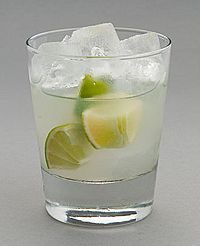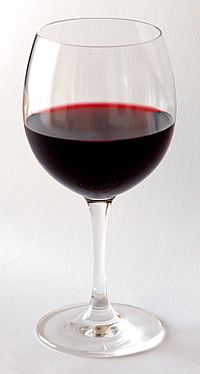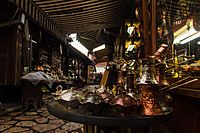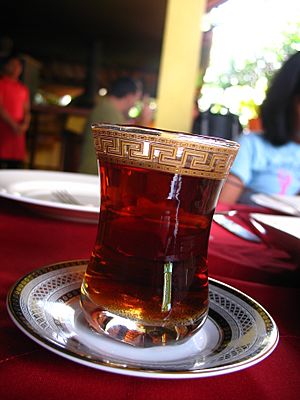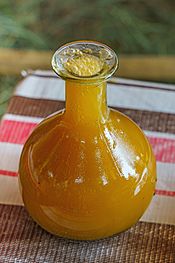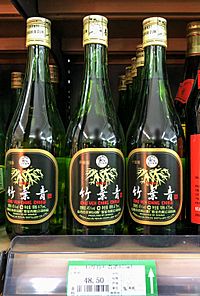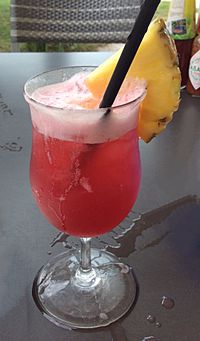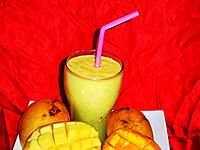List of national drinks facts for kids
A national drink is a distinct beverage that is strongly associated with a particular country, and can be part of their national identity and self-image. A beverage can be considered a national drink for a variety of reasons:
- It is a common drink, made from a selection of locally available foodstuffs that can be prepared in a distinctive way, such as mango lassi that uses dahi, a traditional yogurt or fermented milk product, originating from the Indian subcontinent, usually prepared from cow's milk, and sometimes buffalo milk, goat milk or camel's milk.
- It contains a particular 'exotic' ingredient that is produced locally.
- It is served as a festive culinary tradition that forms part of a cultural heritage.
- It has been promoted as a national dish by the country itself.
In some cases, it may be impossible to settle on a national drink for a particular country. In the realm of food at least, it may be impossible to choose a single national dish, even unofficially, for countries such as Mexico, China, or India because of their diverse ethnic populations and cultures. Though Tadi has been termed as national drink of India. At the other end of the spectrum, sometimes different countries see the same beverage as their national drink (e.g., pisco sour in Peru and Chile).
The national drinks below are categorized within geo-political regions modified from the United Nations' five "regional groups".
Contents
America
North
 Canada: A Caesar is a cocktail that originated in Calgary, and is widely drunk in all parts of Canada. Similar to a Bloody Mary, it contains vodka, a blend of tomato juice, clam broth, hot sauce, and Worcestershire sauce, and is served with ice in a salt-rimmed glass, typically garnished with a stalk of celery and wedge of lime. What distinguishes the two is that only the Caesar contains clam broth. Calgary officially celebrated an anniversary of its creation and launched a national petition for it to be recognized as the official cocktail of Canada.
Canada: A Caesar is a cocktail that originated in Calgary, and is widely drunk in all parts of Canada. Similar to a Bloody Mary, it contains vodka, a blend of tomato juice, clam broth, hot sauce, and Worcestershire sauce, and is served with ice in a salt-rimmed glass, typically garnished with a stalk of celery and wedge of lime. What distinguishes the two is that only the Caesar contains clam broth. Calgary officially celebrated an anniversary of its creation and launched a national petition for it to be recognized as the official cocktail of Canada. United States: Coffee was defiantly adopted as an alternative to British tea in the period leading up to the American Revolution. Coca-Cola is America's iconic soft drink, with the name of the drink referring to two of its original ingredients: coca leaves and kola nuts (a source of caffeine). Pepsi is another popular soft drink. Bourbon (whiskey), named for Bourbon County, Kentucky, is a corn whiskey aged in charred oak barrels. It was proclaimed the U.S. National Spirit by an act of Congress in 1964.
United States: Coffee was defiantly adopted as an alternative to British tea in the period leading up to the American Revolution. Coca-Cola is America's iconic soft drink, with the name of the drink referring to two of its original ingredients: coca leaves and kola nuts (a source of caffeine). Pepsi is another popular soft drink. Bourbon (whiskey), named for Bourbon County, Kentucky, is a corn whiskey aged in charred oak barrels. It was proclaimed the U.S. National Spirit by an act of Congress in 1964. Mexico: Tequila is a liquor distilled from the blue agave plant, primarily in the area surrounding the city of Tequila, of the central western Mexican state of Jalisco. In 2018, the Mexican government approved a proposal to celebrate every third Saturday of March as National Tequila Day. Aguas frescas are also quite popular, two notable ones being Jamaica and horchata. Margarita.
Mexico: Tequila is a liquor distilled from the blue agave plant, primarily in the area surrounding the city of Tequila, of the central western Mexican state of Jalisco. In 2018, the Mexican government approved a proposal to celebrate every third Saturday of March as National Tequila Day. Aguas frescas are also quite popular, two notable ones being Jamaica and horchata. Margarita.
Central and South
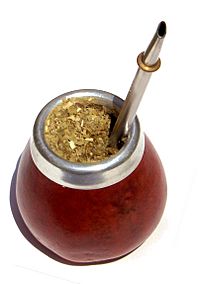
 Antigua and Barbuda: Rum
Antigua and Barbuda: Rum Argentina: Mate is an infusion that is prepared by soaking dried yerba mate leaves in hot water and served with a metal straw and a hollow calabash. This is served and shared in the round, making it an integral part of society. Its origin is shared with Uruguay, Paraguay and southern Brazil. Fernet con cola is a cocktail that consists in Cola and Fernet on ice. It is usually prepared with Coca-Cola and Fernet Branca. The fernet with cola was created in the city of Córdoba and is an emblem of that province.
Argentina: Mate is an infusion that is prepared by soaking dried yerba mate leaves in hot water and served with a metal straw and a hollow calabash. This is served and shared in the round, making it an integral part of society. Its origin is shared with Uruguay, Paraguay and southern Brazil. Fernet con cola is a cocktail that consists in Cola and Fernet on ice. It is usually prepared with Coca-Cola and Fernet Branca. The fernet with cola was created in the city of Córdoba and is an emblem of that province. Bahamas: Switcha
Bahamas: Switcha Barbados: Mauby
Barbados: Mauby Belize: Rum Punch
Belize: Rum Punch Bermuda: Rum swizzle, Dark N' Stormy (Only classified as such if made with Gosling's Dark Rum only made in Bermuda.)
Bermuda: Rum swizzle, Dark N' Stormy (Only classified as such if made with Gosling's Dark Rum only made in Bermuda.) Bolivia (Plurinational State of): Chuflay, Singani
Bolivia (Plurinational State of): Chuflay, Singani Brazil: Caipirinha is a well-known cocktail made of cachaça, lime, and sugar, while Guaraná is a carbonated soft drink made from a fruit originating in Amazonia.
Brazil: Caipirinha is a well-known cocktail made of cachaça, lime, and sugar, while Guaraná is a carbonated soft drink made from a fruit originating in Amazonia. Curaçao: Curaçao liqueur is traditionally made with the dried peels of the Laraha, which is a bitter orange native to Curaçao. The liqueur is distilled along with sweet fragrant oils, derived from the dried Laraha peels. Following distillation blue or orange colors are added for an exotic appearance.
Curaçao: Curaçao liqueur is traditionally made with the dried peels of the Laraha, which is a bitter orange native to Curaçao. The liqueur is distilled along with sweet fragrant oils, derived from the dried Laraha peels. Following distillation blue or orange colors are added for an exotic appearance. Chile: Pisco sour
Chile: Pisco sour Colombia: Aguardiente, coffee
Colombia: Aguardiente, coffee Costa Rica: Imperial
Costa Rica: Imperial Cuba: Cuba Libre, Mojito, Daiquiri
Cuba: Cuba Libre, Mojito, Daiquiri Dominica: Mama Juana
Dominica: Mama Juana Dominican Republic: Mama Juana
Dominican Republic: Mama Juana Ecuador: Chicha
Ecuador: Chicha El Salvador: Pilsener, Champagne cola
El Salvador: Pilsener, Champagne cola Grenada: Rum Punch
Grenada: Rum Punch Guatemala: Gallo
Guatemala: Gallo Guyana: Mauby
Guyana: Mauby Haiti: Barbancourt is a rum produced and bottled in Haiti by Société du Rhum Barbancourt, one Haiti's oldest companies. It is made by distillation of sugar cane juice rather than the sugar cane by-product molasses. Fermentation of fresh sugar cane juice is considered to provide a more flavorful product.
Haiti: Barbancourt is a rum produced and bottled in Haiti by Société du Rhum Barbancourt, one Haiti's oldest companies. It is made by distillation of sugar cane juice rather than the sugar cane by-product molasses. Fermentation of fresh sugar cane juice is considered to provide a more flavorful product. Honduras: Pinol
Honduras: Pinol Jamaica: Rum Punch
Jamaica: Rum Punch Nicaragua: Macuá
Nicaragua: Macuá Panama: Seco Herrerano
Panama: Seco Herrerano Paraguay: Mate is an infusion that is prepared by soaking dried yerba mate leaves in hot water and served with a metal straw and a hollow calabash. This is served and shared in the round, making it an integral part of society. Its origin is shared with Argentina and Uruguay.
Paraguay: Mate is an infusion that is prepared by soaking dried yerba mate leaves in hot water and served with a metal straw and a hollow calabash. This is served and shared in the round, making it an integral part of society. Its origin is shared with Argentina and Uruguay.- '
 Peru: Pisco sour's' name comes from pisco, which is its base liquor, and the cocktail term sour, in reference to sour citrus juice and sweetener components. The drink originated in the city of Pisco. Inca Kola, a lemon verbena based soda, is also popular.
Peru: Pisco sour's' name comes from pisco, which is its base liquor, and the cocktail term sour, in reference to sour citrus juice and sweetener components. The drink originated in the city of Pisco. Inca Kola, a lemon verbena based soda, is also popular.  Puerto Rico (US): Pina colada
Puerto Rico (US): Pina colada Saint Kitts and Nevis: Rum
Saint Kitts and Nevis: Rum Saint Lucia: Bounty brand Rum
Saint Lucia: Bounty brand Rum Saint Vincent and the Grenadines: Golden Apple Juice
Saint Vincent and the Grenadines: Golden Apple Juice Suriname: Kasiri
Suriname: Kasiri Trinidad and Tobago: Queen's Park Swizzle
Trinidad and Tobago: Queen's Park Swizzle Uruguay: Mate is an infusion that is prepared by soaking dried yerba mate leaves in hot water and served with a metal straw and a hollow calabash. This is served and shared in the round, making it an integral part of society. Its origin is shared with Argentina and Paraguay.
Uruguay: Mate is an infusion that is prepared by soaking dried yerba mate leaves in hot water and served with a metal straw and a hollow calabash. This is served and shared in the round, making it an integral part of society. Its origin is shared with Argentina and Paraguay. Venezuela (Bolivarian Republic of): Rum, tizana
Venezuela (Bolivarian Republic of): Rum, tizana
Europe

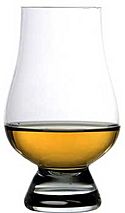
 Albania: Raki
Albania: Raki Andorra: Catalan Brandy, Wine
Andorra: Catalan Brandy, Wine Austria: Almdudler
Austria: Almdudler Belarus: Byarozavik is a traditional Belarusian drink made from birch sap, achieving widespread popularity in the Soviet Union before undergoing a modern resurgence.
Belarus: Byarozavik is a traditional Belarusian drink made from birch sap, achieving widespread popularity in the Soviet Union before undergoing a modern resurgence. Belgium: Belgium is situated in the “Beer belt” and is known for its beers and breweries.
Belgium: Belgium is situated in the “Beer belt” and is known for its beers and breweries. Bosnia and Herzegovina: Rakija, coffee
Bosnia and Herzegovina: Rakija, coffee Bulgaria: Bulgaria considers Rakia to be its national beverage, as well as the place of origin of this distilled beverage that can be made from fruits like plums and apricots.
Bulgaria: Bulgaria considers Rakia to be its national beverage, as well as the place of origin of this distilled beverage that can be made from fruits like plums and apricots. Croatia: Rakija, Pelinkovac
Croatia: Rakija, Pelinkovac Cyprus: Zivania, Brandy sour (unofficial)
Cyprus: Zivania, Brandy sour (unofficial) Czech Republic: Pilsner is a pale lager originating in Plzeň.
Czech Republic: Pilsner is a pale lager originating in Plzeň. Denmark: Akavit, Brännvin, Snaps, Gammel Dansk
Denmark: Akavit, Brännvin, Snaps, Gammel Dansk Estonia: Viru Valge, koduõlu (homebrew beer), kama
Estonia: Viru Valge, koduõlu (homebrew beer), kama Finland: Lonkero
Finland: Lonkero France: Red wine is a type of wine made from dark-colored (black) grape varieties. Champagne is the typical white wine of France.
France: Red wine is a type of wine made from dark-colored (black) grape varieties. Champagne is the typical white wine of France. Germany: Lager, Fanta
Germany: Lager, Fanta Georgia: Chacha and Red wine
Georgia: Chacha and Red wine Greece: Ouzo is a dry anise-flavoured aperitif that is widely consumed in Greece and Cyprus.
Greece: Ouzo is a dry anise-flavoured aperitif that is widely consumed in Greece and Cyprus. Hungary: Pálinka
Hungary: Pálinka Iceland: Brennivín, Appelsín
Iceland: Brennivín, Appelsín Ireland: Guinness is a dark Irish dry stout. Irish whiskey is also popular.
Ireland: Guinness is a dark Irish dry stout. Irish whiskey is also popular. Italy: Chinotto is a type of carbonated soft drink produced from the juice of the fruit of the myrtle-leaved orange tree (Citrus myrtifolia); Wine; Spritz; Grappa; Espresso; Cappuccino
Italy: Chinotto is a type of carbonated soft drink produced from the juice of the fruit of the myrtle-leaved orange tree (Citrus myrtifolia); Wine; Spritz; Grappa; Espresso; Cappuccino Kosovo: Rakia and Semoj, fermented cabbage juice
Kosovo: Rakia and Semoj, fermented cabbage juice Latvia: Riga Black Balsam
Latvia: Riga Black Balsam Liechtenstein: Blauburgunder
Liechtenstein: Blauburgunder Lithuania: Midus, Gira
Lithuania: Midus, Gira Luxembourg: Crémant de Luxembourg
Luxembourg: Crémant de Luxembourg Malta: Kinnie, Bajtra liqueur (unofficial), cactus pear liquor, Maltese falcon
Malta: Kinnie, Bajtra liqueur (unofficial), cactus pear liquor, Maltese falcon Moldova: Divin (Distilled Wine, portmanteau of Distilat de Vin)
Moldova: Divin (Distilled Wine, portmanteau of Distilat de Vin) Monaco: Champagne
Monaco: Champagne Montenegro: Rakija
Montenegro: Rakija Netherlands: Jenever
Netherlands: Jenever North Macedonia: Rakija, Boza
North Macedonia: Rakija, Boza Norway: Akvavit, Solo
Norway: Akvavit, Solo Poland: Like some other central European countries, in Poland vodka is considered to be its national beverage. Along with cereal grains, Poland is also known for distilling it from potatoes. Another popular drink is Krupnik.
Poland: Like some other central European countries, in Poland vodka is considered to be its national beverage. Along with cereal grains, Poland is also known for distilling it from potatoes. Another popular drink is Krupnik. Portugal: Port wine is a sweet Portuguese fortified wine produced with distilled grape spirits in the Douro Valley in the northern provinces of Portugal and is commonly served as a dessert wine. There are also distinct sorts of non port portuguese wines produced in particular regions.
Portugal: Port wine is a sweet Portuguese fortified wine produced with distilled grape spirits in the Douro Valley in the northern provinces of Portugal and is commonly served as a dessert wine. There are also distinct sorts of non port portuguese wines produced in particular regions. Romania: Țuică, sometimes referred to as "white lightning" due to its clarity and potency, is a plum fruit brandy, that is distilled in a brass still, using traditional fire sources such as wood and charcoal. Țuică is traditionally drank prior to meals and at celebrations.
Romania: Țuică, sometimes referred to as "white lightning" due to its clarity and potency, is a plum fruit brandy, that is distilled in a brass still, using traditional fire sources such as wood and charcoal. Țuică is traditionally drank prior to meals and at celebrations. Russia: Kvass is a traditional fermented non-alcoholic beverage commonly made from rye bread.
Russia: Kvass is a traditional fermented non-alcoholic beverage commonly made from rye bread. San Marino: Biancale
San Marino: Biancale Serbia: Rakija.
Serbia: Rakija. Slovakia: Borovička .
Slovakia: Borovička . Slovenia: Schnapps
Slovenia: Schnapps Spain: A punch, sangria traditionally consists of red wine and chopped fruit, often with other ingredients such as orange juice or brandy.
Spain: A punch, sangria traditionally consists of red wine and chopped fruit, often with other ingredients such as orange juice or brandy. Sweden: Brännvin, Punsch, Akvavit
Sweden: Brännvin, Punsch, Akvavit Switzerland: Rivella.
Switzerland: Rivella.
 Ukraine: Horilka, Kvass
Ukraine: Horilka, Kvass United Kingdom: Tea
United Kingdom: Tea
 England: Gin
England: Gin Scotland Scotch is a whisky that is by law required to be both produced in Scotland and aged in oak barrels for at least three years. Irn-Bru (pronounced "Iron Brew") is a sweet, fruity flavoured, soda with a rusty orange color that has been referred to as the country's "other national drink."
Scotland Scotch is a whisky that is by law required to be both produced in Scotland and aged in oak barrels for at least three years. Irn-Bru (pronounced "Iron Brew") is a sweet, fruity flavoured, soda with a rusty orange color that has been referred to as the country's "other national drink." Wales: Perry
Wales: Perry
Africa
 Algeria: Tea
Algeria: Tea Angola: Cuca Beer
Angola: Cuca Beer Benin: Sodabi
Benin: Sodabi Botswana: Chibuku Shake Shake is a traditional beer that originated in Botswana, and now other African countries manufacture it. Keone Mooka Mageu is a traditional fermented porridge, but it is drunk. Ginger beer is a favorite non-alcoholic homemade drink which is served at special occasions, like weddings and parties.
Botswana: Chibuku Shake Shake is a traditional beer that originated in Botswana, and now other African countries manufacture it. Keone Mooka Mageu is a traditional fermented porridge, but it is drunk. Ginger beer is a favorite non-alcoholic homemade drink which is served at special occasions, like weddings and parties. Burkina Faso: Zoomkoom
Burkina Faso: Zoomkoom Burundi: Sorghum beer
Burundi: Sorghum beer Cabo Verde: Grogue
Cabo Verde: Grogue Cameroon: Odontol
Cameroon: Odontol Central African Republic: Karkanji, Coffee
Central African Republic: Karkanji, Coffee Chad: Jus de Fruit, Tea
Chad: Jus de Fruit, Tea Comoros: Singani
Comoros: Singani Congo: Lotoko
Congo: Lotoko Côte d'Ivoire: Akpeteshie
Côte d'Ivoire: Akpeteshie Democratic Republic of the Congo: Lotoko
Democratic Republic of the Congo: Lotoko Djibouti: Kabisa (Djiboutian energy drink, there is no national or popular drink in Djibouti due to strict laws from the government.)
Djibouti: Kabisa (Djiboutian energy drink, there is no national or popular drink in Djibouti due to strict laws from the government.) Egypt: Black tea, Sugarcane juice
Egypt: Black tea, Sugarcane juice Equatorial Guinea: Malamba Juice
Equatorial Guinea: Malamba Juice Eritrea: Sawi, coffee, araki, tea
Eritrea: Sawi, coffee, araki, tea Ethiopia: Coffee, Tej
Ethiopia: Coffee, Tej Eswatini: Sibebe
Eswatini: Sibebe Gabon: Regab
Gabon: Regab Gambia (Republic of The):
Gambia (Republic of The): Ghana: Akpeteshie (National spirit)
Ghana: Akpeteshie (National spirit) Guinea: Malamba Juice
Guinea: Malamba Juice Guinea-Bissau: Cana de Cajeu
Guinea-Bissau: Cana de Cajeu Kenya: Tea, Dawa cocktail
Kenya: Tea, Dawa cocktail Lesotho: Tholoana
Lesotho: Tholoana Liberia: Ginger beer
Liberia: Ginger beer Libya: Libyan tea, Arabic coffee
Libya: Libyan tea, Arabic coffee Madagascar: Rum
Madagascar: Rum Malawi: Thobwa
Malawi: Thobwa Mali: Green tea
Mali: Green tea Mauritania: Tea, Zrig (camel milk)
Mauritania: Tea, Zrig (camel milk) Mauritius: Alouda
Mauritius: Alouda Morocco: Moroccan mint tea (atai) is a green tea prepared with spearmint leaves and sugar.
Morocco: Moroccan mint tea (atai) is a green tea prepared with spearmint leaves and sugar. Mozambique: Tipo Tinto
Mozambique: Tipo Tinto Namibia: Oshikundu, Beer (Either brewed domestically or from Germany.)
Namibia: Oshikundu, Beer (Either brewed domestically or from Germany.) Niger: Biere Niger
Niger: Biere Niger Nigeria: Akpeteshie
Nigeria: Akpeteshie Rwanda: Ikigage, sorghum beer
Rwanda: Ikigage, sorghum beer São Tomé and Príncipe: Palm Wine
São Tomé and Príncipe: Palm Wine Senegal: Bissap
Senegal: Bissap Seychelles: Buka
Seychelles: Buka Sierra Leone: Poyo
Sierra Leone: Poyo Somalia: No official drink, however Shah hawaash (Cardamom tea), coffee, and camel milk are popular
Somalia: No official drink, however Shah hawaash (Cardamom tea), coffee, and camel milk are popular South Africa: No official drink but Beer, Springbokkie and Boeber are common
South Africa: No official drink but Beer, Springbokkie and Boeber are common South Sudan: Araqi
South Sudan: Araqi Sudan: No official drink, however Roselle tea, Araqi, Gongolez (baobab drink), Hulu-Murr (spiced sorghum beverage) and Aradaib (tamarind) are popular
Sudan: No official drink, however Roselle tea, Araqi, Gongolez (baobab drink), Hulu-Murr (spiced sorghum beverage) and Aradaib (tamarind) are popular Togo: Tchakpallo
Togo: Tchakpallo Tunisia: Tea
Tunisia: Tea Uganda: Waragi
Uganda: Waragi United Republic of Tanzania: Konyagi, tea, coffee
United Republic of Tanzania: Konyagi, tea, coffee Zambia: Munkoyo
Zambia: Munkoyo Zimbabwe: Chibuku
Zimbabwe: Chibuku
Asia
East
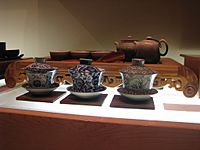
 China: Tea has been a vital part of the Chinese culture for thousands of years. China is considered to have the earliest records of tea consumption, with possible records dating back to the 10th century BC. Depending on different traditional methods in processing the tea leaves, Chinese tea can be classified into at least six distinct categories, namely white tea, yellow tea, green tea, oolong tea, black tea and post-fermented tea (dark tea).
China: Tea has been a vital part of the Chinese culture for thousands of years. China is considered to have the earliest records of tea consumption, with possible records dating back to the 10th century BC. Depending on different traditional methods in processing the tea leaves, Chinese tea can be classified into at least six distinct categories, namely white tea, yellow tea, green tea, oolong tea, black tea and post-fermented tea (dark tea).
- The Chinese national liquor, Baijiu (Chinese: 白酒; pinyin: báijiǔ; literally "white (clear) liquor") is a distilled alcoholic beverage made from various types of grains, including rice, glutinous rice, wheat, barley, and millet. Baijiu was first made 5,000 years ago. Baijiu can be broken down into five main aroma categories: strong, light, sauce (soy, specifically), rice, and mixed.
 Hong Kong: Hong Kong-style milk tea
Hong Kong: Hong Kong-style milk tea Macau: Coffee (typically served with condensed milk) and tea
Macau: Coffee (typically served with condensed milk) and tea Taiwan: Bubble tea (also known as pearl milk tea, bubble milk tea, or boba) is a Taiwanese tea-based drink invented in the 1980s.
Taiwan: Bubble tea (also known as pearl milk tea, bubble milk tea, or boba) is a Taiwanese tea-based drink invented in the 1980s. Japan: Green Tea. Tea consumption became popular among the gentry during the 12th century, after the publication of Eisai's Kissa Yōjōki. Uji, with its strategic location near the capital at Kyoto, became Japan's first major tea-producing region during this period. Beginning in the 13th and 14th centuries, Japanese tea culture developed the distinctive features for which it is known today, and the Japanese tea ceremony emerged as a key component of that culture.
Japan: Green Tea. Tea consumption became popular among the gentry during the 12th century, after the publication of Eisai's Kissa Yōjōki. Uji, with its strategic location near the capital at Kyoto, became Japan's first major tea-producing region during this period. Beginning in the 13th and 14th centuries, Japanese tea culture developed the distinctive features for which it is known today, and the Japanese tea ceremony emerged as a key component of that culture.
- Sake, also referred to as Japanese rice wine, is a beverage made by fermenting rice that has been polished to remove the bran.
 Mongolia: Airag (Mongolian: айраг [ˈai̯rəɡ]) or, in some areas, tsegee is a fermented dairy product traditionally made from mare's milk. The drink remains important to the peoples of the Central Asian steppes, of Huno-Bulgar, Turkic and Mongol origin: Kazakhs, Bashkirs, Kalmyks, Kyrgyz, Mongols, and Yakuts. A 1982 source reported 230,000 horses were kept in the Soviet Union specifically for producing milk to make into kumis. Rinchingiin Indra, writing about Mongolian dairying, says "it takes considerable skill to milk a mare" and describes the technique: the milker kneels on one knee, with a pail propped on the other, steadied by a string tied to an arm. One arm is wrapped behind the mare's rear leg and the other in front. A foal starts the milk flow and is pulled away by another person, but left touching the mare's side during the entire process. In Mongolia, the milking season for horses traditionally runs between mid-June and early October. During one season, a mare produces approximately 1,000 to 1,200 litres of milk, of which about half is left to the foals.
Mongolia: Airag (Mongolian: айраг [ˈai̯rəɡ]) or, in some areas, tsegee is a fermented dairy product traditionally made from mare's milk. The drink remains important to the peoples of the Central Asian steppes, of Huno-Bulgar, Turkic and Mongol origin: Kazakhs, Bashkirs, Kalmyks, Kyrgyz, Mongols, and Yakuts. A 1982 source reported 230,000 horses were kept in the Soviet Union specifically for producing milk to make into kumis. Rinchingiin Indra, writing about Mongolian dairying, says "it takes considerable skill to milk a mare" and describes the technique: the milker kneels on one knee, with a pail propped on the other, steadied by a string tied to an arm. One arm is wrapped behind the mare's rear leg and the other in front. A foal starts the milk flow and is pulled away by another person, but left touching the mare's side during the entire process. In Mongolia, the milking season for horses traditionally runs between mid-June and early October. During one season, a mare produces approximately 1,000 to 1,200 litres of milk, of which about half is left to the foals. North Korea: On June 18, 2019, Kim Jong-un designated Pyongyang Soju an alcoholic beverage that embodies the "innocent and tender hearts" of the North Korean people as the national beverage of North Korea, according to a state propaganda service. Soju is a clear, colorless distilled beverage of Korean origin.
North Korea: On June 18, 2019, Kim Jong-un designated Pyongyang Soju an alcoholic beverage that embodies the "innocent and tender hearts" of the North Korean people as the national beverage of North Korea, according to a state propaganda service. Soju is a clear, colorless distilled beverage of Korean origin. South Korea: Soju (/ˈsoʊdʒuː/; from Korean: Hangul: 소주; Hanja: 燒酒 [so.dʑu]) is a clear, colorless distilled beverage of Korean origin. While soju is traditionally made from rice, wheat, or barley, modern producers often replace rice with other starches such as potatoes, sweet potatoes, or tapioca.
South Korea: Soju (/ˈsoʊdʒuː/; from Korean: Hangul: 소주; Hanja: 燒酒 [so.dʑu]) is a clear, colorless distilled beverage of Korean origin. While soju is traditionally made from rice, wheat, or barley, modern producers often replace rice with other starches such as potatoes, sweet potatoes, or tapioca.
Southeast
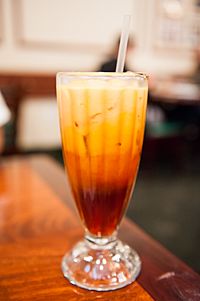
 Brunei: No national drink, however Air Batu Campur (ABC) is popular among citizens.
Brunei: No national drink, however Air Batu Campur (ABC) is popular among citizens. Cambodia: Sombai infused rice wine.
Cambodia: Sombai infused rice wine. Indonesia: Es teler, a sweet iced concoction created by Murniati Widjaja, who won a competition to come up with a national drink for Indonesia in 1982.
Indonesia: Es teler, a sweet iced concoction created by Murniati Widjaja, who won a competition to come up with a national drink for Indonesia in 1982. Laos: Lao-Lao (Lao: ເຫລົ້າລາວ) is a Laotian rice whisky produced in Laos. Along with Beerlao, lao-Lao is a staple drink in Laos. The name lao-Lao is not the same word repeated twice, but two different words pronounced with different tones: the first, ເຫລົ້າ is pronounced with a low-falling tone in the standard dialect, while the second, ລາວ, means Laotian ("Lao") and is pronounced with a high(-rising) tone.
Laos: Lao-Lao (Lao: ເຫລົ້າລາວ) is a Laotian rice whisky produced in Laos. Along with Beerlao, lao-Lao is a staple drink in Laos. The name lao-Lao is not the same word repeated twice, but two different words pronounced with different tones: the first, ເຫລົ້າ is pronounced with a low-falling tone in the standard dialect, while the second, ລາວ, means Laotian ("Lao") and is pronounced with a high(-rising) tone. Malaysia: Teh tarik (literally "pulled tea") is a hot milk tea beverage which can be commonly found in restaurants, outdoor stalls and kopi tiams. Its name is derived from the pouring process of "pulling" the drink during preparation. It is made from a strong brew of black tea blended with condensed milk. It is the national drink of Malaysia.
Malaysia: Teh tarik (literally "pulled tea") is a hot milk tea beverage which can be commonly found in restaurants, outdoor stalls and kopi tiams. Its name is derived from the pouring process of "pulling" the drink during preparation. It is made from a strong brew of black tea blended with condensed milk. It is the national drink of Malaysia. Myanmar: Lahpet yay is brewed from a mix of fermented or pickled tea, sweetened condensed milk, and evaporated milk. It is traditionally served hot in Burmese tea houses - open air, bustling, street corner places.
Myanmar: Lahpet yay is brewed from a mix of fermented or pickled tea, sweetened condensed milk, and evaporated milk. It is traditionally served hot in Burmese tea houses - open air, bustling, street corner places. Philippines: San Miguel Beer.
Philippines: San Miguel Beer. Singapore: Kopi is a type of traditional highly caffeinated black coffee, sometimes served with milk and/or sugar. This drink has Hainanese roots, many of which migrated south to Singapore during the 19th to 20th centuries. It is also otherwise known as Nanyang coffee. Nanyang means ‘South Sea’ in Mandarin, and usually references to Southeast Asia. The Singapore coffee is recognized to be culturally significant and part of the everyday diet and lifestyle of many Singaporeans.
Singapore: Kopi is a type of traditional highly caffeinated black coffee, sometimes served with milk and/or sugar. This drink has Hainanese roots, many of which migrated south to Singapore during the 19th to 20th centuries. It is also otherwise known as Nanyang coffee. Nanyang means ‘South Sea’ in Mandarin, and usually references to Southeast Asia. The Singapore coffee is recognized to be culturally significant and part of the everyday diet and lifestyle of many Singaporeans.- The Singapore Sling is a gin-based sling cocktail from Singapore. It was created before 1915 by Ngiam Tong Boon (Chinese: 严崇文; pinyin: Yán Chóng-Wén), also of Hainanese descent, at the Long Bar in Raffles Hotel, Singapore, and is considered the national cocktail.
- Tiger Beer is considered the national beer of Singapore.
- The Milo dinosaur is a Singaporean chocolate malt–based beverage composed of a cup of iced Milo with undissolved Milo powder added on top of it. It is usually served cold to prevent the powder from immediately dissolving in the drink. It originates from Indian Singaporean eateries in Singapore during the 1990s, and it is now most commonly found in mamak stalls, kopitiams and hawker centres from all ethnic groups in Singapore.
 Thailand: Thai tea is a Thai drink made from tea, milk and sugar, and served hot or cold. It is popular in Southeast Asia and is served in many restaurants that serve Thai food. When served cold it is known as Thai iced tea. Another highly popular drink is Krating Daeng, an energy drink which was first introduced in 1976. In Thai, daeng means red, and a krating is a large species of wild bovine native to South Asia. Krating Daeng inspired the creation of the Western drink Red Bull.
Thailand: Thai tea is a Thai drink made from tea, milk and sugar, and served hot or cold. It is popular in Southeast Asia and is served in many restaurants that serve Thai food. When served cold it is known as Thai iced tea. Another highly popular drink is Krating Daeng, an energy drink which was first introduced in 1976. In Thai, daeng means red, and a krating is a large species of wild bovine native to South Asia. Krating Daeng inspired the creation of the Western drink Red Bull. Timor-Leste: Cachaca
Timor-Leste: Cachaca Vietnam: Rượu nếp, Vietnamese rice wine, made from glutinous rice that has been fermented with the aid of yeast and steamed in a banana lea.
Vietnam: Rượu nếp, Vietnamese rice wine, made from glutinous rice that has been fermented with the aid of yeast and steamed in a banana lea.
South
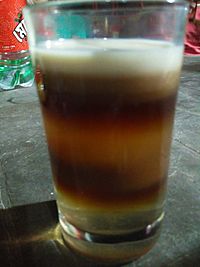
 Bangladesh: Tea (Bengali: চা, romanized: Cha) is considered to be the national drink of Bangladesh, with government bodies such as the Bangladesh Tea Board and the Bangladesh Tea Research Institute supporting the production, certification, and exportation of the tea trade in the country. Recently, new types of tea, such as the seven color tea or seven-layer tea, (Bengali: সাত রং চা, romanized: Shat Rong Cha) has popped up as a well-known beverage of the country's Sylhet Division. Romesh Ram Gour invented the seven-layer tea after discovering that different tea leaves have different densities. Each layer contrasts in color and taste, ranging from syrupy sweet to spicy clove. The result is an alternating dark/light band pattern throughout the drink, giving the tea its name.
Bangladesh: Tea (Bengali: চা, romanized: Cha) is considered to be the national drink of Bangladesh, with government bodies such as the Bangladesh Tea Board and the Bangladesh Tea Research Institute supporting the production, certification, and exportation of the tea trade in the country. Recently, new types of tea, such as the seven color tea or seven-layer tea, (Bengali: সাত রং চা, romanized: Shat Rong Cha) has popped up as a well-known beverage of the country's Sylhet Division. Romesh Ram Gour invented the seven-layer tea after discovering that different tea leaves have different densities. Each layer contrasts in color and taste, ranging from syrupy sweet to spicy clove. The result is an alternating dark/light band pattern throughout the drink, giving the tea its name. Bhutan: Ara, or Arag, is a traditional alcoholic beverage consumed in Bhutan. Ara is made from native and high-altitude tolerant barley, rice, maize, millet, or wheat, and may be either fermented or distilled. The beverage is usually a clear, creamy, or white color.
Bhutan: Ara, or Arag, is a traditional alcoholic beverage consumed in Bhutan. Ara is made from native and high-altitude tolerant barley, rice, maize, millet, or wheat, and may be either fermented or distilled. The beverage is usually a clear, creamy, or white color. India: Tea is the most widely consumed beverage in India. Lassi or Chaas is another yogurt-based drink and can be sweet or salty. Lassi or Chaas is a blend of yogurt, water, spices and sometimes fruit like mango. While the Masala chai is a hot, sweet tea popular throughout the subcontinent and is a combination of brewed black tea, aromatic spices, and herbs, milk and sugar. In southern India, the iconic beverage is Kaapi, also known as Indian filter coffee, which is made by mixing frothed and boiled milk with coffee brewed through a metal filter.
India: Tea is the most widely consumed beverage in India. Lassi or Chaas is another yogurt-based drink and can be sweet or salty. Lassi or Chaas is a blend of yogurt, water, spices and sometimes fruit like mango. While the Masala chai is a hot, sweet tea popular throughout the subcontinent and is a combination of brewed black tea, aromatic spices, and herbs, milk and sugar. In southern India, the iconic beverage is Kaapi, also known as Indian filter coffee, which is made by mixing frothed and boiled milk with coffee brewed through a metal filter. Maldives: It can be said that the Maldives have two national drinks. Firstly, due to their history and location near the Indian Subcontinent, sai (tea) is a Maldivian favorite. Secondly, as the Maldives are truly an Island nation, raa (toddy tapped from palm trees) is also has its place in the national identity of the Maldives. Sometimes raa is left to ferment and is thus slightly alcoholic.
Maldives: It can be said that the Maldives have two national drinks. Firstly, due to their history and location near the Indian Subcontinent, sai (tea) is a Maldivian favorite. Secondly, as the Maldives are truly an Island nation, raa (toddy tapped from palm trees) is also has its place in the national identity of the Maldives. Sometimes raa is left to ferment and is thus slightly alcoholic. Nepal: Raksi is a strong drink, clear like vodka or gin, tasting somewhat like Japanese sake. It is usually made from kodo millet (kodo) or rice; different grains produce different flavors. The Limbus, for whom it is a traditional beverage, drink an enormous amount of Tongba and raksi served with pieces of pork, water buffalo or goat meat sekuwa. For the Newars, aylaa is indispensable during festivals and various religious rituals as libation, prasad or sagan.
Nepal: Raksi is a strong drink, clear like vodka or gin, tasting somewhat like Japanese sake. It is usually made from kodo millet (kodo) or rice; different grains produce different flavors. The Limbus, for whom it is a traditional beverage, drink an enormous amount of Tongba and raksi served with pieces of pork, water buffalo or goat meat sekuwa. For the Newars, aylaa is indispensable during festivals and various religious rituals as libation, prasad or sagan. Pakistan: Sugarcane juice, Chai.
Pakistan: Sugarcane juice, Chai. Sri Lanka: Tea
Sri Lanka: Tea
Central
 Afghanistan: Technically no official however tea and doogh are popular
Afghanistan: Technically no official however tea and doogh are popular Kazakhstan: Kumis, fermented horse milk
Kazakhstan: Kumis, fermented horse milk Kyrgyzstan: maksym or jarma, both of which are made out of barley
Kyrgyzstan: maksym or jarma, both of which are made out of barley Tajikistan: Green tea
Tajikistan: Green tea Turkmenistan: Chal
Turkmenistan: Chal Uzbekistan: Green tea
Uzbekistan: Green tea
West
 Armenia: Oghi, Armenian wine, Ararat (brandy)
Armenia: Oghi, Armenian wine, Ararat (brandy) Azerbaijan: Black tea, Ayran
Azerbaijan: Black tea, Ayran Bahrain: coffee
Bahrain: coffee Georgia: Chacha and Red wine
Georgia: Chacha and Red wine Iraq: coffee, Arak, and Mint tea
Iraq: coffee, Arak, and Mint tea Iran: Doogh, Persian yogurt drink and Black tea, Aragh sagi (underground)
Iran: Doogh, Persian yogurt drink and Black tea, Aragh sagi (underground) Israel: Arak, Goldstar
Israel: Arak, Goldstar Jordan: Arabic coffee, non-sweetened and in small shots, Mint lemonade, and arak
Jordan: Arabic coffee, non-sweetened and in small shots, Mint lemonade, and arak Kuwait: Arabic coffee (kahwah)
Kuwait: Arabic coffee (kahwah) Lebanon: Arak
Lebanon: Arak Oman: Arabic coffee
Oman: Arabic coffee Palestine: coffee, Arak, mint lemonade
Palestine: coffee, Arak, mint lemonade Qatar: Arabic coffee
Qatar: Arabic coffee Saudi Arabia: Arabic coffee
Saudi Arabia: Arabic coffee Syria: coffee and Arak
Syria: coffee and Arak Turkey: raki; tea; ayran (as proclaimed by Prime Minister Tayyip Erdogan in 2013) is a non-alcoholic yogurt drink
Turkey: raki; tea; ayran (as proclaimed by Prime Minister Tayyip Erdogan in 2013) is a non-alcoholic yogurt drink United Arab Emirates: Arabic Coffee
United Arab Emirates: Arabic Coffee Yemen: Arabic Coffee, being one of the oldest known places to grow coffee, Qishr, and Naqe'e Al Zabib
Yemen: Arabic Coffee, being one of the oldest known places to grow coffee, Qishr, and Naqe'e Al Zabib
Oceania
 American Samoa (US): Kava
American Samoa (US): Kava Australia: An ABC News article published in 2018 described lemon, lime, and bitters (LLB) as "Australia's national drink". Lemon, lime, and bitters is a mixed drink made with (clear) lemonade, lime cordial, and Angostura bitters. The lemonade is sometimes substituted with soda water or lemon squash.
Australia: An ABC News article published in 2018 described lemon, lime, and bitters (LLB) as "Australia's national drink". Lemon, lime, and bitters is a mixed drink made with (clear) lemonade, lime cordial, and Angostura bitters. The lemonade is sometimes substituted with soda water or lemon squash. Cook Islands: Tumunu
Cook Islands: Tumunu Easter Island: Easter Island Cocktail
Easter Island: Easter Island Cocktail Fiji: Most Fijians would say that Kava is the unofficial national drink of Fiji. In Fiji, kava (also called "grog" or "yaqona") is drunk at all times of day in both public and private settings. The consumption of the drink is a form of welcome and figures in important socio-political events. Both genders drink kava. Kava is consumed for its sedating effects throughout the Pacific Ocean cultures of Polynesia, including Hawaii, Vanuatu, Melanesia, and some parts of Micronesia. To a lesser extent, it is consumed in nations where it is exported as an herbal medicine.
Fiji: Most Fijians would say that Kava is the unofficial national drink of Fiji. In Fiji, kava (also called "grog" or "yaqona") is drunk at all times of day in both public and private settings. The consumption of the drink is a form of welcome and figures in important socio-political events. Both genders drink kava. Kava is consumed for its sedating effects throughout the Pacific Ocean cultures of Polynesia, including Hawaii, Vanuatu, Melanesia, and some parts of Micronesia. To a lesser extent, it is consumed in nations where it is exported as an herbal medicine. French Polynesia: Hinano Lager
French Polynesia: Hinano Lager Guam (US): Calamansi Basil Lemonade
Guam (US): Calamansi Basil Lemonade Hawaii (US): Mai tai
Hawaii (US): Mai tai Kiribati: Karewe is a palm wine beverage made from "Toddy" (sap of certain coconut palms) in Kiribati. It is said that "Every male child in Kiribati is expected to learn climbing and toddy cutting from very early age just as a female child is expected to learn cooking and weaving from very early age". It is known by various names in different regions and is common in various parts of Asia, Africa, the Caribbean, South America, and Micronesia. Karewe production by small landholders and individual farmers may promote conservation as palm trees become a source of regular household income that may economically be worth more than the value of timber sold.
Kiribati: Karewe is a palm wine beverage made from "Toddy" (sap of certain coconut palms) in Kiribati. It is said that "Every male child in Kiribati is expected to learn climbing and toddy cutting from very early age just as a female child is expected to learn cooking and weaving from very early age". It is known by various names in different regions and is common in various parts of Asia, Africa, the Caribbean, South America, and Micronesia. Karewe production by small landholders and individual farmers may promote conservation as palm trees become a source of regular household income that may economically be worth more than the value of timber sold. Marshall Islands: Coconut Water
Marshall Islands: Coconut Water Micronesia: Sakau
Micronesia: Sakau Nauru: Iced Coffee
Nauru: Iced Coffee New Caledonia: Wine
New Caledonia: Wine New Zealand: L&P
New Zealand: L&P Niue: Coconut Water
Niue: Coconut Water Northern Mariana Islands: Michelob Ultra
Northern Mariana Islands: Michelob Ultra Palau: Coconut Water
Palau: Coconut Water Papua New Guinea: Kava
Papua New Guinea: Kava Pitcairn Islands: Ti Punch
Pitcairn Islands: Ti Punch Samoa: Kava
Samoa: Kava Solomon Islands: Kava
Solomon Islands: Kava Tokelau: Kava
Tokelau: Kava Tonga: Kava is a very important drink in Tonga, and some would also argue that it is their unofficial national drink. Only men are allowed to drink kava, although women who serve it may be present. The female server is usually an unmarried, young woman called "touʻa." In the past, this was a position reserved for women being courted by an unmarried male, and much respect was shown. These days, it is imperative that the touʻa not be related to anyone in the kalapu, and if someone is found to be a relative of the touʻa, he (not the touʻa) will leave the club for that night; otherwise the brother-sister taboo would make it impossible to talk openly, especially about courtship. Foreign girls, especially volunteer workers from overseas are often invited to be a touʻa for a night. If no female touʻa can be found, or it is such a small, very informal gathering, one of the men will do the job of serving the kava root; this is called fakatangata ("all-man"). See Tongan Kava Ceremony for more information.
Tonga: Kava is a very important drink in Tonga, and some would also argue that it is their unofficial national drink. Only men are allowed to drink kava, although women who serve it may be present. The female server is usually an unmarried, young woman called "touʻa." In the past, this was a position reserved for women being courted by an unmarried male, and much respect was shown. These days, it is imperative that the touʻa not be related to anyone in the kalapu, and if someone is found to be a relative of the touʻa, he (not the touʻa) will leave the club for that night; otherwise the brother-sister taboo would make it impossible to talk openly, especially about courtship. Foreign girls, especially volunteer workers from overseas are often invited to be a touʻa for a night. If no female touʻa can be found, or it is such a small, very informal gathering, one of the men will do the job of serving the kava root; this is called fakatangata ("all-man"). See Tongan Kava Ceremony for more information. Tuvalu: Kava
Tuvalu: Kava Vanuatu: Kava drink
Vanuatu: Kava drink Wake Island: Beer
Wake Island: Beer Wallis and Futuna: Kava
Wallis and Futuna: Kava
Gallery
-
Kaapi, Indian filter coffee.
-
Peach kompot, traditional to several countries in Eastern and Southeastern Europe.
-
Krupnik, a national drink of Poland.
-
Kvass, popular in the Baltic and Slavic countries.
-
Krating Daeng, an energy drink, created in Thailand.
-
The new Seven Color Tea, a recent competitor for national drink of Bangladesh.
-
Indian Masala chai served in a red clay tea cup.


